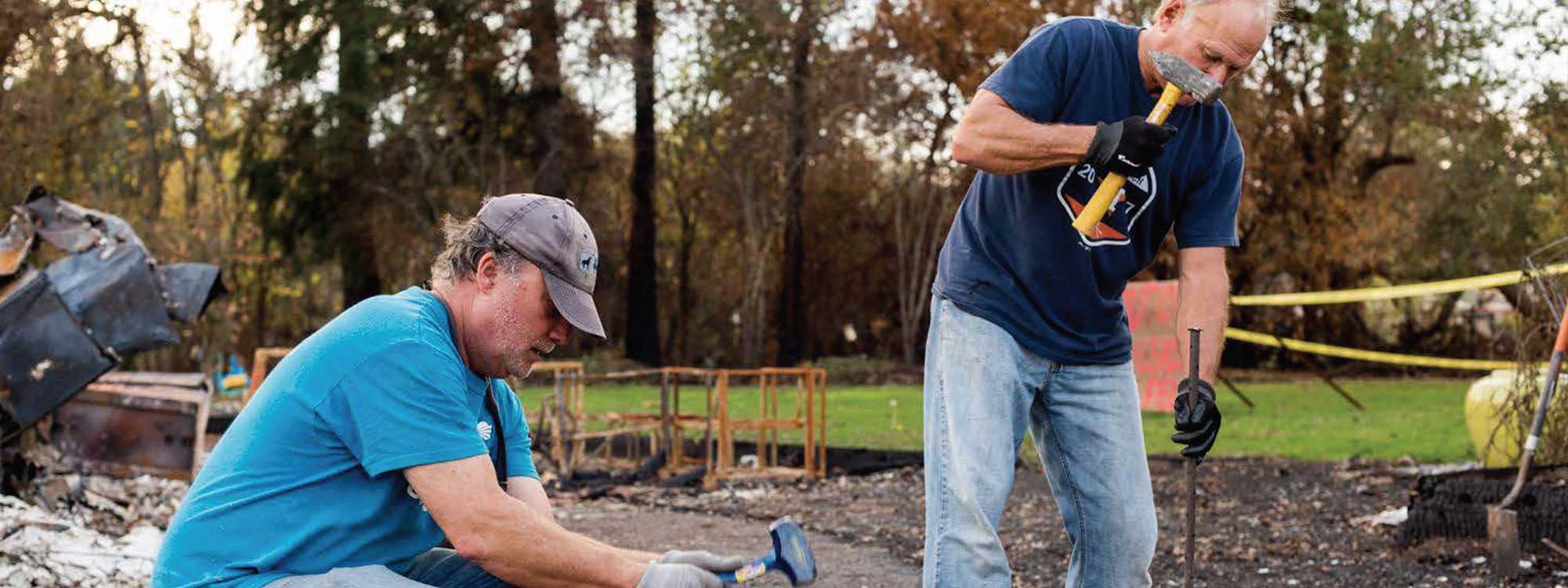As the new year unfolds, the people and landscapes of the North Bay are slowly healing and moving toward recovery and rebuilding.
The Land Will Recover
Open space lands are already growing green among the charred trunks and limbs of oaks and other trees that survived the fires. After all, California’s flora and fauna evolved with wildfires over centuries.
Taking a walk through Sonoma Valley Regional Park in Glen Ellen, you can hardly tell that the fires scorched the landscape. To see the transformation first hand, join us for a firewalk on Feb. 3 to look for fire follower plants and flowers.
This video from Sonoma County Regional Parks shows a hillside before, during and after the Nuns Fire—portraying the wildfire’s behavior, as well as how the land and wildlife respond.
The immediate challenge comes from future rain and storms. Land managers and an army of volunteers are hard at work laying down miles of straw wattles to prevent soil erosion and slow stormwater runoff. Sonoma County recently issued a flood and mudflow alert with maps showing the high-risk areas.
Resilient Rebuilding
Rebuilding the neighborhoods where more than 5,100 homes were lost to the fires in Sonoma County will be a marathon, not a sprint, according to Santa Rosa’s fire chief.
At the same time, the City and County have moved very quickly on new urgency measures to streamline approval of rebuilding permits. The City of Santa Rosa recently established a new Resilient City Rebuild Permit Center focused on a quick rebuild. Sonoma County is also easing building review and waiving fees for residents who lost their homes.
Greenbelt Alliance supports a streamlined process for homeowners rebuilding what they had before while updating to current building codes as required. We are also advocating for options and incentives that will allow homeowners to build greener, energy efficient, fire resistant homes.
For rebuilding homes that are larger than the original, particularly on hillsides, Greenbelt Alliance argued and won stronger oversight provisions before approval. We also worked with the City Council to ensure that any new development in the burned areas goes through the normal approval process. We need to ensure that fire risk is fully evaluated before putting more people in harm’s way.
Greenbelt Alliance urges that in rural areas, the County should avoid rebuilding at greater development intensities as it exacerbates fire risks. We are researching ways to enable people wanting to move out of fire-risk areas to do so with 100% voluntary programs to fund fire resiliency and land protection–with no net loss in housing.
Need for Resilient New Housing
The housing crisis before the fires is now exacerbated by the loss of about 3,000 homes or about 5% of the housing stock in Santa Rosa alone. Over the next few weeks and months, the County of Sonoma and many cities will propose new urgency ordinances to fast-track new housing and construction. Greenbelt Alliance is watching to make sure that urgency ordinances passed by cities and counties maintain environmental, public health and safety, affordable housing, and growth policies, as well as include public review and input.
If there is a new wave of construction, to be resilient, it must be contained within urban growth boundaries and unincorporated areas with existing water and sewer, not sprawl into community separators, greenbelts, or agricultural lands.
Initiatives to accelerate new housing and development must be in city centers and along the SMART line near jobs, schools, and shopping. Bike paths, walkways, and connections need always be included.
Affordable housing must be prioritized and existing thresholds maintained or increased, not reduced. We don’t need to sacrifice sensitive habitats or endangered species such as the precious California tiger salamander for development if we do it right!
Greenbelt Alliance is working with elected officials, allies, and City staff to ensure Sonoma County’s vision for fire recovery and rebuilding maintains and enhances greenbelt and good growth policies.
Photo courtesy of the Sonoma Ecology Center
The Sonoma Ecology Center launched the Emergency Watershed Protection program to stabilize sources of potentially toxic runoff into our watershed. The program is engaging landowners, volunteers, and donors to protect Sonoma Valley streams and public health.
If you own burnt structures in Sonoma Valley, please sign their consent form that will allow crews to contain those sites, or visit their website to learn more.




